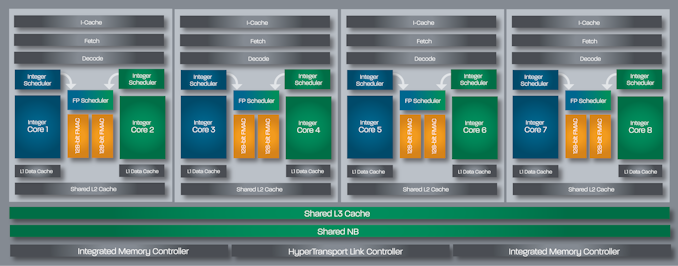AMD Bulldozer 'Core' Lawsuit: AMD Settles for $12.1m, Payouts for Some
by Anton Shilov on August 28, 2019 1:15 PM EST
AMD this month has agreed to pay compensation that totals $12.1 million to users who purchased FX-8000/9000 CPUs via its website or in the state of California. The case comes down to AMD advertising these processors as having 8 cores, and the claim that a shared FPU unit within a 'dual core' module does not constitute an actual core of performance similar to a separate core/FPU unit. Users who qualify for the compensation are estimated to recieve in the region on $35, depending on the exact uptake, and no one person can claim more than $7500.
AMD’s Bulldozer microarchitecture used 'dual-core modules' containing two independent ALUs and a shared FPU. AMD believed that such design allowed it to call its FX-8000 and FX-9000 series processors as the industry’s first eight-core desktop CPUs, yet the latter were quite often behind their quad-core rivals from Intel in terms of performance. As a result, a group of people from California filed a class action suit that accused AMD of false advertising back in 2015.
In early 2019, the Northern District Court of California sided with the plaintiffs and ruled that AMD’s FX-8120, FX-8150, FX-8320, FX-8350, FX-8370, FX-9370, and FX-9590 processors were incorrectly advertised as having eight cores. On August 23, the court published the class action settlement agreement under which AMD agreed to pay plaintiffs and the settlement class a compensation.
Under the terms of the deal, AMD has to create a $12.1 million settlement fund that will cover compensations to the end users, attorney fees, and settlement administration fees. The Class Counsel agreed to limit its petition for attorneys’ fees and reimbursement of expenses to no more than 30% of the fund, or $3.630 million, whereas the costs of settlement administration will be between $350,000 and $700,000. As a result, the pot to share between the actual purchasers of AMD’s select FX processors will be between $7.77 million and $8.12 million.
Purchasers entitled for up to $7500 total, have a confirmed purchase(s), and to have purched one of the processors while living in California or from AMD's website. It is noteworthy that people who bought AMD’s FX-8000E series CPUs with reduced power consumption are not eligible to get a reimbursement, and neither are people who purchased AMD’s six-core and quad-core FX-6000 and FX-4000 products.
It is hard to estimate how much money will each owner of AMD’s FX-8120, FX-8150, FX-8320, FX-8350, FX-8370, FX-9370, and FX-9590 processors will get, but considering the fact the settlement is limited to select CPUs and residents of California and those from AMD.com, actual sums may be quite sizeable. Should the actual value per unit be over $300, this will be subject to court approval.
AMD and the Settlement Administrator are order to crease a website at www.AMDCPUSettlement.com that should include the ability to file claim forms online. At press time, the website was offline, but it should be up shortly. We are awaiting AMD's official press release on the matter.
Update:
AMD has given an official comment on the result:
"AMD is pleased to have reached a settlement of this lawsuit. While we believe the allegations are without merit, we also believe that eliminating the distraction and settling the litigation is in our best interest."
Related Reading
- AMD's Steamroller Detailed: 3rd Generation Bulldozer Core
- The Bulldozer Review: AMD FX-8150 Tested
- The Bulldozer Aftermath: Delving Even Deeper
Sources: PACER, The Register (click through for document filing)











81 Comments
View All Comments
Oxford Guy - Thursday, August 29, 2019 - link
It is no such thing.1) A Bulldozer-style design (in terms of there being more integer hardware than floating point hardware) is more efficient for workloads that involve little to no floating point on the CPU.
2) AMD's designs, Bulldozer and Piledriver, had bugs and other drawbacks — like L3 cache performance that wasn't much better than DRAM and AVX performance that wasn't much better than SSE. AVX may have even regressed from the change of Bulldozer to Piledriver. They were certainly not the pinnacle of the CMT concept and were frozen in time while Intel continued to extract IPC increases with its many incremental improvements over Sandy.
Oxford Guy - Thursday, August 29, 2019 - link
Some other design flaws and drawbacks:1) Inadequate micro-op caching, when compared with Sandy.
2) Too-heavy reliance on automated tools, resulting in transistor count bloat.
3) Very deep pipeline probably not efficient for desktop-oriented code, particularly of its time.
rocky12345 - Thursday, August 29, 2019 - link
The CPU is a hybrid of sorts yes it can do up to 8 threads and it does do this as advertised. The problem is more how AMD marketing marketed the FX series and made it out to be more than it was. As said it can do 8 threads but at it's heart windows see's it as a 4/8 setup kind of like windows see's Intel's i7's up to the 7700 CPU as a 4/8.Oxford Guy - Thursday, August 29, 2019 - link
How Windows, Cinebench, or other software's coders decide to classify it only proves one thing: how they chose to classify it. It's my understanding, too, that Windows had both 8 and 4 core classifications for the same 8 core FX chips at different times in its development.ballsystemlord - Thursday, August 29, 2019 - link
I was hoping someone would do this. A core should be at least one INT and one FLOAT unit, not one INT and one half FLOAT.Oxford Guy - Thursday, August 29, 2019 - link
That's arbitrary. A workload that offloads FP work to a GPU or other specialized processor has zero need for FP on a CPU — making the 1:1 INT to FP ratio a ridiculously inefficient use of die space.Similarly, workloads that use little or no FP do not need your "should" mandate.
Oxford Guy - Thursday, August 29, 2019 - link
It's droll that when AMD led in floating point performance, all the benchmarkers pushed the importance of integer. Then, when AMD focused on integer at the expense of float, suddenly floating point performance is the cat's meow.It's also droll that so few realize that Bulldozer wasn't designed for desktop users. It was designed for enterprise. It's not accidental that a good number of supercomputers in top-performance lists used lots of Piledrivers.
The other things many forget:
1) Intel cheated on security to improve performance.
2) AMD's high-performance CPU design was static from Piledriver until the time of Zen 1, which was a very long time for a part that already lagged the competition.
AntonErtl - Friday, August 30, 2019 - link
For those who think that FX-8xxx does not have 8 cores: Consider an alternative Bulldozer design, where half of the 4 64-bit FP adders and half of the 4 64-bit FMACs of a module was assigned exclusively to one core; and likewise, where each core got exclusive access to half of the I-cache and L2 cache, and the instruction fetchers and decoders were halved in size. You would get a CPU that would have even worse single-thread, and probably also worse 8-thread performance than Bulldozer, but even some clueless judge would find no reason not to call such a castrated FX-8xxx an 8-core CPU.This shows that buying by the number of cores and suing on this basis is foolish. OTOH, marketing by the number of cores tries to exploit this folly and this makes it ethically questionable; does AMD deserve to get punished for that? Maybe, but then I would like to see other ethically questionable marketing punished, too.
If you only read one other comment, read KAlmquist's excellent comment https://www.anandtech.com/comments/14804/amd-settl...
Hardware Hound - Friday, August 30, 2019 - link
In the end, my biggest issue with this settlement is in the performance. FX did have solid multi-core benchmarks, indicating that the 8 cores were legit. The main performance issue the series had (as previously mentioned) was the single-thread. Settling in that regard seems like a mistake.However, I'm also dealing with a lot of marketing projects to help the hospital I work at try and pass a tax increase vote. Public perception requires weighing out a ton of pros and cons. I think AMD made the smart move by settling. It not only seems to be saving them the potential litigation costs, but it's a solid move for consumer good will, so to speak.
Had this gone to trial though, I have a feeling AMD could have won the case eventually if they really wanted to fight it.
johnniedoo - Saturday, August 22, 2020 - link
I actually got a check from AMD looks like. i deposited it into my checking /savings account and it has been returned to me and instructs me to deal with the maker of the check...AMD or the Clerk who administered the paltry 12.1 million bucks...